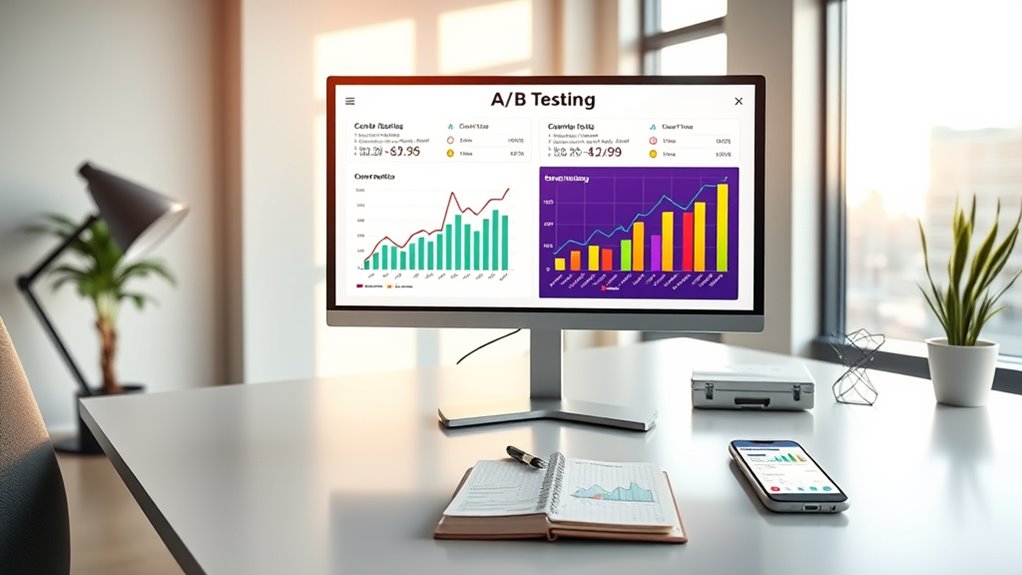In marketing, leveraging A/B testing and conversion rate optimization helps you make data-driven decisions that boost your results. By testing different website elements, offers, or messaging, you discover what resonates best with your audience. Simplifying processes and personalizing content increases conversions and keeps users engaged. Focusing on these strategies lets you continuously refine your campaigns for better outcomes. Keep exploring to uncover how these techniques can transform your marketing efforts.
Key Takeaways
- A/B testing compares different versions of marketing elements to determine which performs best.
- Conversion Rate Optimization focuses on improving the user journey to increase conversions.
- Data-driven insights from testing help eliminate guesswork and inform strategic decisions.
- Personalization enhances user engagement by tailoring content based on testing results.
- Continuous testing and optimization lead to sustained improvements in marketing effectiveness.

In today’s competitive digital landscape, understanding how to improve your marketing efforts is essential for success. One of the most effective ways to do this is by leveraging A/B testing and conversion rate optimization (CRO). These techniques allow you to make data-driven decisions that refine your campaigns, increase user engagement, and ultimately drive more conversions. To maximize their impact, you should focus on implementing personalization strategies that resonate with your audience. Personalization helps you tailor content, offers, and messaging to meet individual preferences, which keeps users more engaged and encourages them to take desired actions. When you use personalization strategies effectively, you create a more relevant experience for each visitor, boosting user engagement and making your marketing efforts more impactful.
A/B testing is your tool for systematically comparing different versions of your website, emails, or ads to see which performs better. Instead of guessing what works best, you test variables like headlines, images, calls to action, or layout changes. By running these tests, you gather insights on what elements resonate most with your audience, allowing you to optimize your content accordingly. This process is continuous, so you constantly refine your approach based on real user data. For instance, you might find that a certain color for your call-to-action button yields higher click-through rates. Armed with this knowledge, you can implement changes that drive better results across your campaigns. Additionally, understanding cultural narratives and how they influence audience perceptions can help tailor your messaging for greater resonance.
Conversion rate optimization takes these insights further by analyzing your entire user journey. It involves identifying barriers that prevent visitors from converting and removing or reducing them. This could mean simplifying your checkout process, making your landing pages more persuasive, or personalizing content based on user behavior. When you focus on CRO, you’re not just increasing traffic; you’re ensuring that more of your visitors become paying customers or loyal followers. Personalization plays a vital role here because it helps you craft tailored experiences that address individual needs and preferences, increasing the likelihood of conversion.
Frequently Asked Questions
How Do I Choose the Right Metrics for A/B Testing?
To choose the right metrics for A/B testing, focus on those that directly reflect user engagement and align with your goals. Prioritize metrics that provide data accuracy and meaningful insights, like click-through rates, bounce rates, or conversion rates. Avoid vanity metrics that don’t impact your objectives. By selecting relevant, precise metrics, you can make informed decisions that genuinely improve your performance.
What Tools Are Best for Conversion Rate Optimization?
You’ll find that tools like Optimizely, VWO, and Google Optimize are your best allies for conversion rate optimization, enabling you to craft personalized strategies and refine user experience design effortlessly. These platforms allow you to run sophisticated tests, analyze data in real-time, and implement impactful changes. With them, you can unleash the full potential of your website, transforming visitors into loyal customers at an astonishing rate.
How Often Should I Run A/B Tests for Best Results?
You should run A/B tests regularly, ideally every few weeks, to find your test frequency’s ideal timing. This helps you stay responsive to changes in user behavior and market trends. Consistent testing ensures continuous improvement, but avoid over-testing, which can lead to analysis paralysis. Focus on key pages or elements, and adjust your test schedule based on your website traffic and goals for the best results.
Can A/B Testing Be Applied to Mobile App Marketing?
Yes, you can definitely apply A/B testing to mobile app marketing. Research shows it’s effective for optimizing user engagement and conversions. You should segment your audience with mobile segmentation to test different features or messages. Use A/B testing to refine your app store optimization strategies, like icons or descriptions. This way, you gather insights that help improve your app’s performance across various demographics, boosting downloads and retention.
What Are Common Pitfalls to Avoid in CRO Strategies?
You should watch out for overconfidence bias, which can make you rely too heavily on initial test results, and confirmation bias, where you only see data that supports your assumptions. Avoid jumping to conclusions too quickly and always validate your findings with further tests. Keep an open mind, analyze all data objectively, and remember that CRO is an ongoing process, not a one-time fix. This approach helps prevent costly mistakes.
Conclusion
So, after all this talk about A/B testing and CRO, you might think you’ve cracked the code. But here’s the irony: no matter how many tests you run, success still hinges on a bit of luck, intuition, and guesswork. Keep experimenting, sure — but don’t forget, even the best data can’t guarantee perfection. In the end, it’s a constant dance between science and art, where sometimes, the biggest wins come from the boldest risks.










